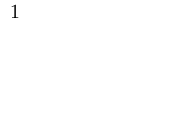Triangular array
In mathematics and computing, a triangular array of numbers, polynomials, or the like, is a doubly indexed sequence in which each row is only as long as the row's own index. That is, the ith row contains only i elements.
Examples
Notable particular examples include these:
- The Bell triangle, whose numbers count the partitions of a set in which a given element is the largest singleton[1]
- Catalan's triangle, which counts strings of parentheses in which no close parenthesis is unmatched[2]
- Euler's triangle, which counts permutations with a given number of ascents[3]
- Floyd's triangle, whose entries are all of the integers in order[4]
- Hosoya's triangle, based on the Fibonacci numbers[5]
- Lozanić's triangle, used in the mathematics of chemical compounds[6]
- Narayana triangle, counting strings of balanced parentheses with a given number of distinct nestings[7]
- Pascal's triangle, whose entries are the binomial coefficients[8]
Triangular arrays of integers in which each row is symmetric and begins and ends with 1 are sometimes called generalized Pascal triangles; examples include Pascal's triangle, the Narayana numbers, and the triangle of Eulerian numbers.[9]
Generalizations
Triangular arrays may list mathematical values other than numbers; for instance the Bell polynomials form a triangular array in which each array entry is a polynomial.[10]
Arrays in which the length of each row grows as a linear function of the row number (rather than being equal to the row number) have also been considered.[11]
Applications
Apart from the representation of triangular matrices, triangular arrays are used in several algorithms. One example is the CYK algorithm for parsing context-free grammars, an example of dynamic programming.[12]
Romberg's method can be used to estimate the value of a definite integral by completing the values in a triangle of numbers.[13]
The Boustrophedon transform uses a triangular array to transform one integer sequence into another.[14]
See also
- Triangular number, the number of entries in such an array up to some particular row
References
- ↑ "A triangle for the Bell numbers", A collection of manuscripts related to the Fibonacci sequence, Santa Clara, Calif.: Fibonacci Association, 1980, pp. 69–71, http://www.fq.math.ca/Books/Collection/shallit.pdf.
- ↑ Kitaev, Sergey; Liese, Jeffrey (2013), "Harmonic numbers, Catalan's triangle and mesh patterns", Discrete Mathematics 313 (14): 1515–1531, doi:10.1016/j.disc.2013.03.017.
- ↑ Velleman, Daniel J.; Call, Gregory S. (1995), "Permutations and combination locks", Mathematics Magazine 68 (4): 243–253, doi:10.2307/2690567.
- ↑ Miller, Philip L.; Miller, Lee W.; Jackson, Purvis M. (1987), Programming by design: a first course in structured programming, Wadsworth Pub. Co., pp. 211–212, ISBN 9780534082444.
- ↑ "Fibonacci triangle", The Fibonacci Quarterly 14 (2): 173–178, 1976.
- ↑ Losanitsch, S. M. (1897), "Die Isomerie-Arten bei den Homologen der Paraffin-Reihe", Chem. Ber. 30 (2): 1917–1926, doi:10.1002/cber.189703002144, https://zenodo.org/record/1425862.
- ↑ Barry, Paul (2011), "On a generalization of the Narayana triangle", Journal of Integer Sequences 14 (4): Article 11.4.5, 22.
- ↑ Edwards, A. W. F. (2002), Pascal's Arithmetical Triangle: The Story of a Mathematical Idea, JHU Press, ISBN 9780801869464.
- ↑ Barry, P. (2006), "On integer-sequence-based constructions of generalized Pascal triangles", Journal of Integer Sequences 9 (6.2.4): 1–34, Bibcode: 2006JIntS...9...24B, http://www.emis.de/journals/JIS/VOL9/Barry/barry91.pdf.
- ↑ Rota Bulò, Samuel; Hancock, Edwin R.; Aziz, Furqan; Pelillo, Marcello (2012), "Efficient computation of Ihara coefficients using the Bell polynomial recursion", Linear Algebra and Its Applications 436 (5): 1436–1441, doi:10.1016/j.laa.2011.08.017.
- ↑ Fielder, Daniel C.; Alford, Cecil O. (1991), "Pascal's triangle: Top gun or just one of the gang?", in Bergum, Gerald E.; Philippou, Andreas N.; Horadam, A. F., Applications of Fibonacci Numbers (Proceedings of the Fourth International Conference on Fibonacci Numbers and Their Applications, Wake Forest University, N.C., U.S.A., July 30–August 3, 1990), Springer, pp. 77–90, ISBN 9780792313090, https://books.google.com/books?id=SfWNxl7K9pgC&pg=PA77.
- ↑ Indurkhya, Nitin; Damerau, Fred J., eds. (2010), Handbook of Natural Language Processing, Second Edition, CRC Press, p. 65, ISBN 9781420085938, https://books.google.com/books?id=nK-QYHZ0-_gC&pg=PA65.
- ↑ Thacher Jr., Henry C. (July 1964), "Remark on Algorithm 60: Romberg integration", Communications of the ACM 7 (7): 420–421, doi:10.1145/364520.364542.
- ↑ Millar, Jessica; Sloane, N. J. A.; Young, Neal E. (1996), "A new operation on sequences: the Boustrouphedon transform", Journal of Combinatorial Theory, Series A 76 (1): 44–54, doi:10.1006/jcta.1996.0087.
External links
 |


